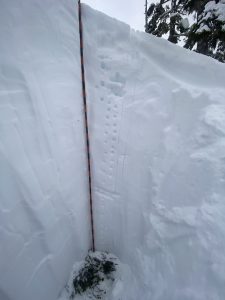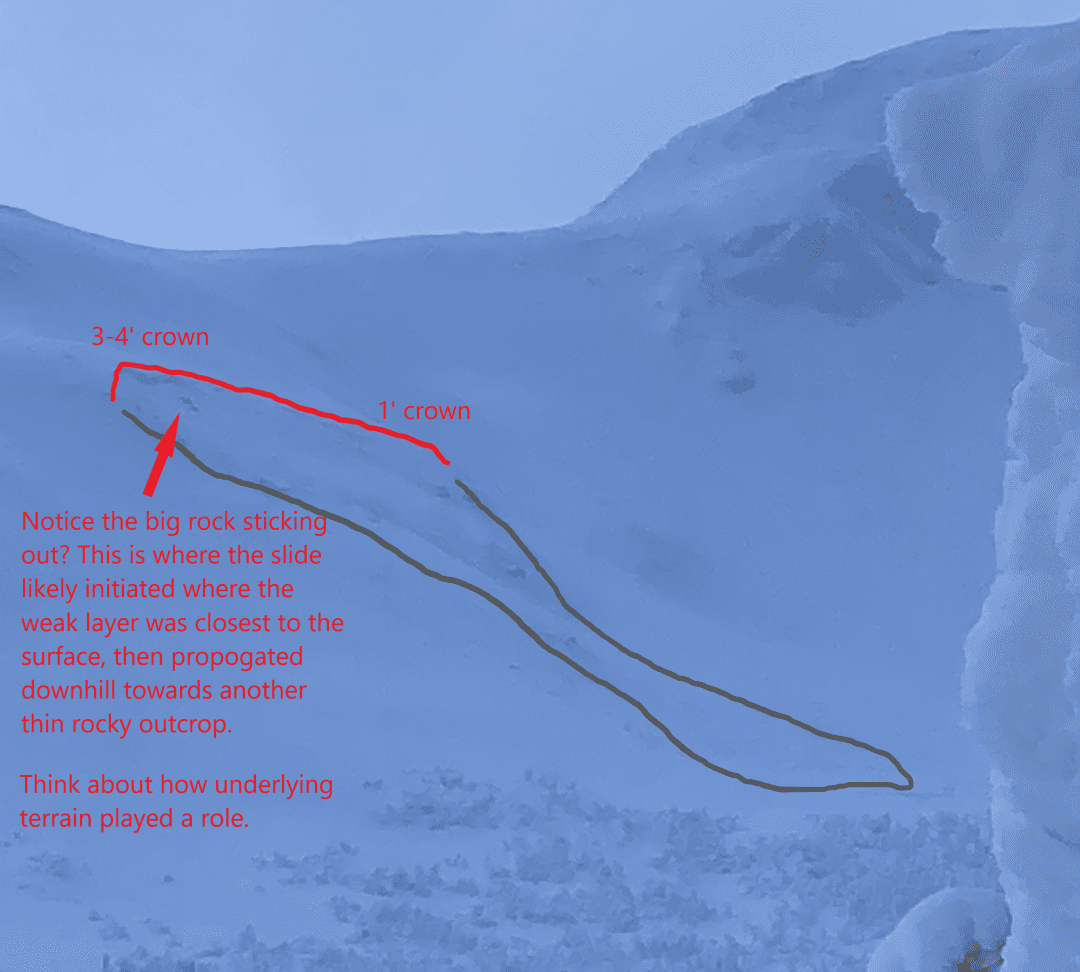Haines Avalanche Center
Above 2,500ftModerate
1,500 to 2,500ftModerate
Below 1,500ftModerate
Degrees of Avalanche Danger
Avalanche Problems
Problem 1
Aspect: All aspects, most likely on wind loaded aspects and features SW-S-SE-E.
Elevation: All elevations, mainly at and above treeline.
The Bottom Line: While triggering an avalanche deeper in the snowpack has become more difficult, strong over weak layering in the upper snowpack could still produce a slide. Remain vigilant around suspect terrain and potential trigger points on exposed slopes greater than 30 degrees, below ridge-lines and in couloirs/gullies. If you venture into new terrain, keep in mind false positive confidence.
Travel advice: Use safe travel techniques such as only exposing one person at a time both on the way up and down. Identify and avoid thin areas where weak layers are more likely to trigger a slide from. Group up in safe zones that are out of harms way. Have good communication, including radios and a set plan in case of an emergency. Be practiced at companion rescue.
- On wind-protected slopes, there is preserved buried surface hoar about 5-10″ deep
- Snowfall Dec. 6-10th alternated with wind events and was blown around by strong NW winds on Dec. 11th. A repeat of the same conditions occurred with NW winds Dec 19th, followed by 6″ of new snow, and now more NW winds.
- Cold temperatures Dec. 3-5th created weak snow at the surface that is now buried in many places
- Over a meter deep: old weak layers are buried and difficult to trigger, but still there.
- Toward the very bottom: early season snowfalls and crusts linger and are very difficult to trigger but are still of concern for step-down potential.
It is still possible that any surface avalanches could step down to deeper weak layers, the October rain crust, or even the ground in alpine areas.
The persistent slab danger is not going away, it is standing by waiting for the right trigger. We have not had a crush and flush cycle, or stabilizing event. Keep in mind that most avalanches are triggered by someone in the group.
Test pit from Dec. 23rd with buried crust 70cm down
Likelihood:
- Almost Certain
- Very Likely
- Likely
- Possible
- Unlikely
Size:
- Historic
- Very Large
- Large
- Small
Trend
- Increasing
- Steady
- Decreasing
Avalanche Activity
We had one report of a small skier-triggered soft slab last weekend in the Lutak zone. It was on a cross-loaded S aspect gully, and likely ran on the 12/18 Surface Hoar layer, about 8″ deep.
Dec 11th: Natural slide on mount Ripinsky’s back bowl caused by wind loading. It ran over a persistent weak layer on a NE aspect at 3,000ft, was 200ft wide and ran 800ft, with a average slope angle measured on Google Earth of 35 degrees.
Weather
Thursday looks like a nice day, before a decent storm brings 5-10″ of new snow Friday-Friday night. Strong NW winds and possibly record cold temperatures are expected Sunday into mid week.
- New snow in the Lutak zone buried any preserved surface hoar on Dec 20th
- Moderate NW winds hit exposed slopes Dec 19-20th
- Surface hoar formed on all aspects and elevations Dec 17-18th
- December brought in about 2-5 feet of snowfall (highest in Lutak zone), and a few strong NW wind events
- November brought consistent heavy snowfalls, cold weather, and SE winds
- October brought heavy snow in the alpine, followed by a few rain/sun crusts
| Snow Depth [in] | Last 24-hr Snow/SWE [in] | Last 3-days Snow/SWE [in] | Today’s Freezing Level [ft] | Today’s Winds | Next 24-hr Snow/SWE | |
| Mount Ripinsky @ treeline ** | 61″* | 0″ / 0.0* | 2″ / 0.15* | 0′ | light, N | 0″ / 0.00* |
| Flower Mountain @ treeline | 43″ | 0″ / 0.00 | 1″ / 0.10 | 0′ | light, NW | 0″ / 0.00* |
| Chilkat Pass @ 3,100ft | 19″ | 0″ / 0.00 | 1″ / 0.10 | 0′ | light, NW | 0″ / 0.00* |
( *star means meteorological estimate )
** The Ripinsky weather station is in need of repair, and will likely be down until Summer.
Additional Information
Be prepared for an emergency and hypothermia. Winter is a high consequence environment. Carry bear spray.
Become a sustaining Haines Avalanche Center Member by clicking the poster or visiting dev.alaskasnow.org/joinHAC. Support local forecasts, observations, education and weather stations. Join a community of winter recreationalists. Benefit from collective knowledge and skills. Help keep your friends and family safe in the backcountry. Get a free limited edition mountain buff, or neck gaiter with a $50 membership (first 20 members!).
Practice like you play. Make sure all your rescue gear is fully functional and your beacon has NEW batteries. Make sure 1) everyone in the group has a functioning beacon, shovel and probe 2) knows how to use them and 3) has trained in companion rescue in the last year. Keep your skills fresh. If you head into the hills, watch out for red flag avalanche conditions, natural avalanches, whoomphing or collapsing, and shooting cracks.
Education Video Links:
- AIARE
- How to Practice Avalanche Rescue Snowmobile Edition: https://youtu.be/2ML499MMDfM
- AK Sled Shed Motorized Learning:
- Intro: https://youtu.be/aoagKHfGkxs
- Personal Electronics in Avalanche Terrain: https://youtu.be/2Vz9S0OEyFk
- Snowmobile Macgyver Tool Kit: https://youtu.be/4WBNu_t6Bbk
- Head and Face Protection: https://youtu.be/jIzW89wOyZI
- Pre-season prep: https://youtu.be/zJmrb8cZlR4
- My Transceiver: https://youtu.be/yblaDWP7Jf8
- BCA Avalanche Safety for Snowmobilers
- How to Fix Common Snowmobile Problems in the Field: https://youtu.be/g9fiTxEvuFk
- Sleducation: Avalanche Safety for Snowmobilers: https://youtu.be/EWFOd_9DYb8
- Intro to Avalanche Transceivers for Snowmobilers: https://youtu.be/6ZLSBmsceog
- Avalanche Transceiver Trailhead Test for Snowmobilers: https://youtu.be/rWoXbadFBsY
- Avalanche Transceiver Searching Use Snowmobiles: https://youtu.be/w1ucyI6LMXM
- BCA Avalanche Rescue Series
- Beacon Search 101: https://youtu.be/nnHXLVA2FcE
- Avalanche Probing 101: https://youtu.be/-0_yDN5Drzw
- Avalanche Shoveling 101: https://youtu.be/dGQg9o3vAkM
- Organizing a Backcountry Rescue: https://youtu.be/gywtmukgt8s
- Post Avalanche Patient Care: https://youtu.be/9FyIeUy4wpQ
- Backcountry Evacuation: https://youtu.be/WPF-dciefL8
- Complex Multiple Burials Backup Techniques: https://youtu.be/pB6AfY2KyYo
- National Avalanche Center
- Avalanche Problems Explained: https://youtu.be/DkbnT_9-cHU
- Intro to North American Avalanche Danger Scale: https://youtu.be/r_-KpOu7tbA
Announcements
Click the –Full Forecast– button below for more details. Please submit your observations!



